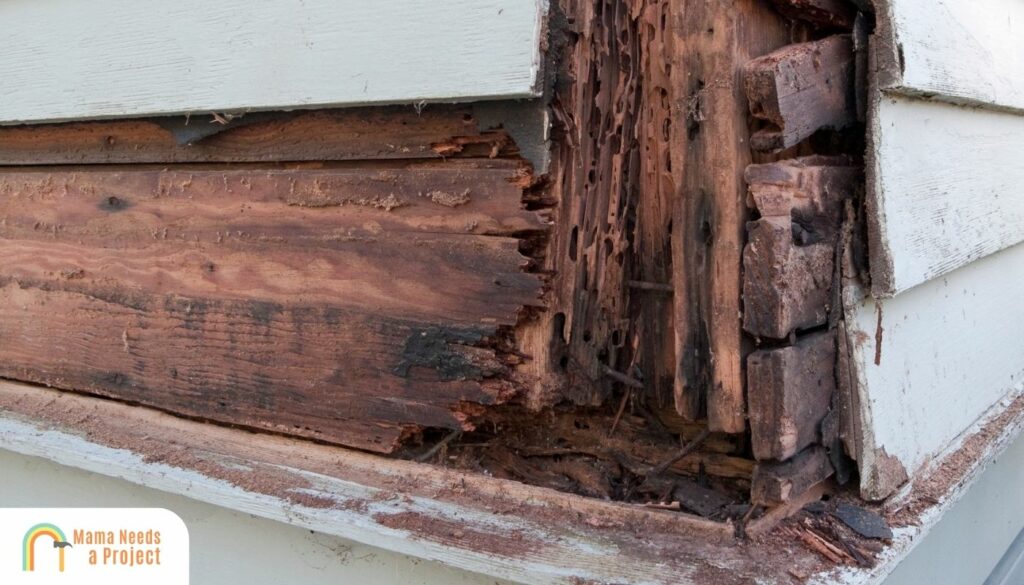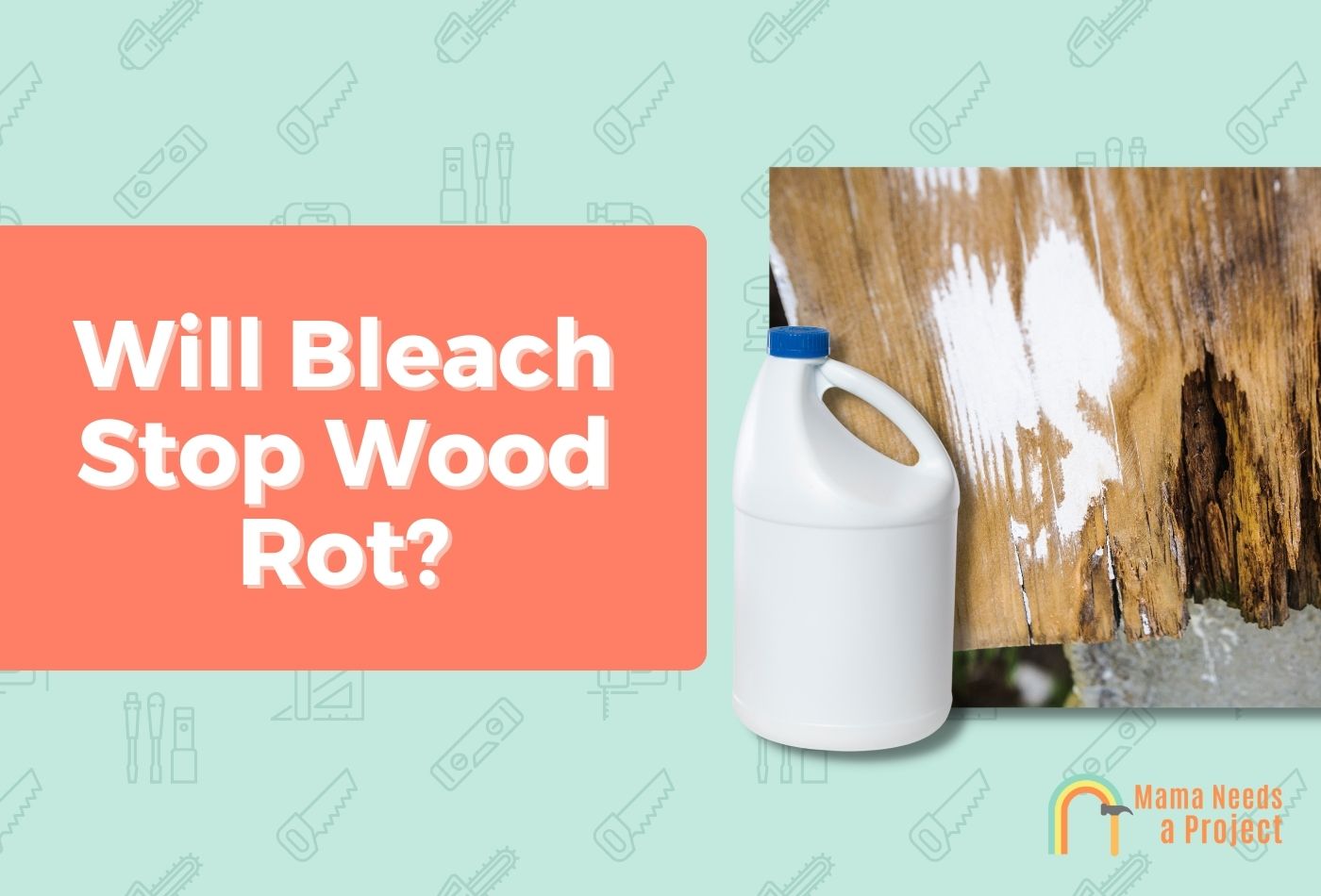Will Bleach Stop Wood Rot? (Quick Answer!)
Bleach is one of the strongest chemicals on earth, and it’s incredibly good at sterilizing a range of surface materials.
But will bleach stop wood rot? The short answer is YES, but there’s more to it than that.
In this guide, I’ll explain if bleach can stop wood rot and some tips to keep wood from rotting. Let’s dig in!
- Yes, bleach will stop wood rot from spreading and damaging wood any further. Chlorine bleach works quickly, so it can eliminate fungus spores and remove rot stains in under an hour.
- But you need to be careful when using bleach to stop wood rot, as it’s extremely toxic and capable of damaging even the strongest wood finishes.
Will Bleach Stop Wood Rot?
Bleach is an ideal solution for stopping wood rot, as it’s effective, easy to use, and readily available.
And even if you dilute chlorine bleach to make it safer, it’ll still stop fungus growth on dry wood.
How to Treat Wood Rot with Bleach

1. Identify The Source
Before you address the rotting wood, you should locate the source of the problem. In other words, find out what’s causing the wood to be overly moist. The source could be a leaking pipe or excessive moisture.
If you address the source before the rotting wood, you won’t have to worry as much about dry rot spores coming back in the future.
2. Prep the Surface
Before you can tackle the dry rot fungus, you need to remove all the rotted wood. After you do this, go over the rot damage with a dry brush to remove any leftover rot fungi.
3. Apply the Bleach
Don’t forget to wear protective gloves, goggles, and a respirator or mask before applying the bleach.
You can dilute the bleach beforehand, but this isn’t necessary.
Generously apply the bleach using a clean, cotton cloth. Once the wood looks dark and damp, let the wood dry for 30 minutes to an hour.
Of course, you could use a bristle brush to apply bleach, but I prefer clean cloths because they afford more control.
Plus, bleach is incredibly hard to remove from brush bristles, so you’d probably have to throw the brush out after using it.
And if the board is small enough, you can soak it in a bleach solution to ensure all fungal growth is eliminated.
4. Repair
If you can salvage what’s left of the rotted sections, apply some wood filler to make the surface look uniform.
But if the rotted sections are beyond repair, you’ll have to cut them off. The silver-lining here is you’ll be left with 100% sound wood.
Types of Rot
Dry Rot
Dry rot is incredibly common, and most of the time it exists without causing any issues.
But it’s when dry rot is allowed to germinate and colonize wood that things become problematic.
At first, dry rot looks a lot like white cotton wool, but eventually it starts to cause cuboidal cracking, i.e. the wood will start to look like graph/grid paper.
And when dry rot is particularly advanced, you’ll see mushroom-like growths among the fungal spores. It’s at this point that the wood is weakest, as the fungus has fed on all the fresh parts.
Dry rot will germinate when a wood surface is more than 20% damp, and it can continue spreading even after the wood has dried out completely. This is why it’s so important to nip dry rot in the bud early.
There are a few things you can do to treat dry rot, and using bleach is a time-tested method.
Wet Rot (White Rot)
Wet rot is another wood-destroying fungus, but unlike dry rot it needs wood that’s at least 50% moist to germinate and colonize. And as it spreads, it feeds on the lignin, which weakens the wood and causes it to look decayed.
If you see a large, abnormal spot that’s darker than what’s around it, this could be wet rot. And usually wood that’s rife with it looks shrunken and brittle, and it feels spongy. Plus it emits a damp, mold smell.
Bleach can eliminate wet rot. Once it’s gone, the wood should be treated to prevent further decay.
Brown Rot
Brown rot isn’t as common as dry or wet rot, but it’s just as damaging and disfiguring.
Essentially, when wet rot fungus feeds on the wood’s sugars and cellulose because it can’t digest its lignin, the result is brown rot—so it’s basically a brown version of white rot.
Again, chlorine bleach can be used to eliminate this wood-destroying fungus, and afterward you should treat the wood to stop wood rot from coming back.
What Else Stops Wood Rot?
Ethylene Glycol
Ethylene glycol, otherwise known as propylene glycol, is used as antifreeze, and like bleach it’s harsh and powerful. Therefore, you need to be careful when using it to eliminate wood rot.
How does it work? Well, ethylene glycol will penetrate deep into the wood fibers, and once there it’ll kill all the fungi spores.
Using ethylene glycol on wood will also prevent rot from germinating in the future.
Best of all, you can apply it to finished wood surfaces because it won’t damage paint, stain, or varnish—the same can’t be said of bleach.
Boric Acid
Boric acid isn’t as effective as ethylene glycol or bleach, but it’s still used throughout the construction industry to treat wood.
Tim-Bor is a water-soluble borate product while Bora-Care is dissolved in ethylene glycol, and both are good at eliminating and preventing wood rot.
You can also mix borax, boric acid, and water in a small pan over a low flame. Then, pour this mixture onto the wood rot. Eventually the mixture will bind and suffocate the wood rot.
How to Prevent Wood Rot
Use Treated Wood
Wood that’s been treated with certain additives and thoroughly kiln-dried is much more moisture-resistant than natural wood, so it’s less prone to rotting.
There is, of course, naturally decay-resistant wood out there, but treated wood tends to outlast it.
In short, preventing wood rot is a lot easier than treating wood rot, so always choose treated wood when it’s feasible to do so.
Treat Wood Yourself
You can treat wood yourself to prevent all the rot fungi that’s out there from damaging it, but you should only do this if you’re comfortable with mixing harsh chemicals.
DIY wood-treating isn’t unbearably difficult. Basically, you need to get the chemical mix right, and you need to know how long the wood must soak for.
And once you do this a few times, you’ll know how to make the perfect DIY wood preservative for preventing rotten wood.
Keep It Dry
Keeping your wood surfaces dry will go a long way in preventing wood rot from taking over.
Therefore, your exterior wood surfaces—deck, fence, stairs, etc.—should be finished with polyurethane or another protective sealant.
And you may even notice wood rot on surfaces indoors, in which case humidity is the likely culprit. So use dehumidifiers to suck excessive moisture out of the air.
Wood rot can also appear on a window frame, and when this happens you must treat the affected wood immediately, otherwise the infected wood will break down and compromise the soundness of the whole frame.
Regular Maintenance
You only need to maintain your wood surfaces a couple times a year to ensure wood rot doesn’t rear its ugly head.
And should you find either dry rot or wet rot during your routine maintenance, all you have to do is dilute chlorine bleach and apply this mixture to the affected wood.
Want to know the different ways to clean wood surfaces? Check out the video down below!
Final Thoughts
To recap, using chlorine bleach is an easy, effective, and affordable way to stop wood rot in its tracks. It can also prevent wood rot from coming back, especially if the wood is dry when bleach is applied.
Finally, you should avoid using bleach on rotted wood that’s stained, painted, or varnished, as bleach breaks down virtually all wood finishes—even polyurethane!

